What’s Your Diagnosis? A TRAP Phenomenon or Something Else?
At 34 weeks’ gestation, a pregnant woman underwent a routine ultrasound examination. The findings revealed an unusual anomaly. Can you identify it?
Presented here is a case involving a 34-week pregnancy for which the patient underwent routine ultrasonography.
History and Examination
A 37-year-old woman underwent routine obstetric ultrasonography at 34 weeks’ gestation. Prior to her pregnancy, her menses had been normal. She had no history of any major illness before the ultrasound examination.
Family history: This patient was 1 of 4 children. This was her third pregnancy (gravid 3 para 2).
Present pregnancy: The patient had a 34-week history of amenorrhea, which almost corresponded with the age of the fetus on ultrasound scan. She had no history of antepartum hemorrhage or discharge during this pregnancy and reported normal fetal movements.
Clinical examination: Blood pressure was normal at 124/82 mm of Hg, as were her other vital signs. Chest examination findings were normal. On abdominal examination, the fundal height of the patient almost corresponded to the gestational age of 34 weeks.
Imaging studies: This patient underwent routine transabdominal ultrasonography to exclude any congenital anomalies. She had not undergone any previous ultrasound scan. The ultrasound images of the current examination follow.
Image 1. Transabdominal B-mode ultrasound scan.
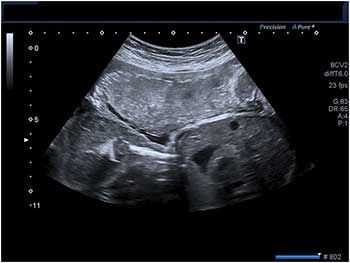
Image 2. Transabdominal B-mode ultrasound scan.
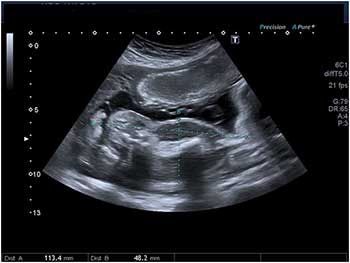
Based on these fetal images, what's your diagnosis?
Sonographic findings: Both images show the fetal trunk to the left. The most striking finding is that there appears to be some mass lesions extending from and located to the right of the fetus, indicating a mass or another fetus. Another image may clarify this.
Image 3. This transabdominal B-mode ultrasound scan shows a mass or lesion extending from the fetus.
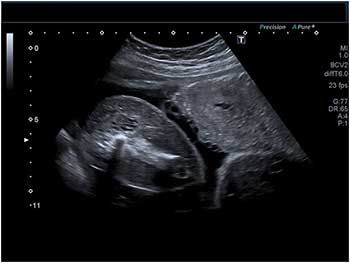
If this is a fetal mass, it should be connected to the fetus. However, there appears to be no direct connection to the fetal trunk. If this is a twin pregnancy, where is the rest of the fetus? Shall we exclude a twin pregnancy?
These findings may indicate a gastroschisis or an omphalocele, but in both gastroschisis and omphalocele one would expect some bowel loops or herniated bowel contents with or without a sac. Since neither bowel loops nor liver can be seen protruding through a defect in the fetal abdomen, what are the implications of these findings? Here's another image.
Image 4. This transabdominal ultrasound with Doppler shows what appears to be a vessel entering the mass near the fetus.
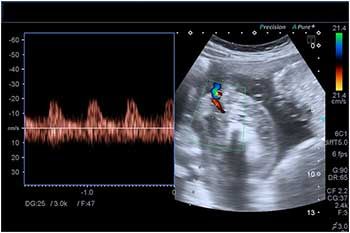
Image 4 shows what appears to be a vessel entering the mass or whatever else is seen near the fetus. This rules out the possibility of omphalocele or gastroschisis. Are we back to a twin pregnancy? Or is it a teratoma? If a teratoma, then where is the continuity with the fetus? All indications suggest a twin pregnancy, but where is the fetal heart in the abnormal twin?
Is this a twin pregnancy with a fetal death? It’s the most plausible choice among the differential diagnoses, but where is the rest of the fetus? Can we think of some form of twin reverse arterial perfusion (TRAP) syndrome? The color Doppler image indicates that this may be a fetus lacking a fetal heart, suggesting that this may be some type of parasitic twin that derives its blood supply from the other donor twin. The images drive us towards the possibility of a twin pregnancy with one of them being a parasite.
Once again, these images show a twin pregnancy with one apparently well-developed fetus and one smaller, poorly developed fetus with a meager blood supply. The poorly developed parasitic twin appears as a mass of tissue that lacks clear definition or morphology. It might well be a poorly developed limb. There is no heart, chest, abdomen, or obvious limbs.
The diagnosis is clear: a fetus lacking a heart indicates holoacardia, a rare condition in which a twin fetus, which is the recipient of a twin-to-twin transfusion syndrome, lacks body parts, including the fetal heart. There are various forms of holoacardia, the most common of which is holoacardia amorphus. In this condition, the fetus is poorly developed, lacks a fetal heart, and shows no clear anatomy and is replaced by a mass of tissue.
Final diagnosis: Twin pregnancy with holoacardia amorphus.
Discussion
In certain twin pregnancies, one fetus receives its blood supply from the adjoining twin via a process known as twin-to-twin transfusion or TRAP syndrome. Because of poor development of the fetal heart, this recipient twin subsequently undergoes fetal death or is sustained by its meager blood supply from the adjoining twin. This process results in gradual desorption of the existing tissues in the deformed fetus.
Some degree of cardiac activity may have been present in the recipient twin early in the pregnancy. However, any such activity was not enough to maintain the deformed fetus. As the pregnancy progresses, the acardiac fetus becomes a mass of tissue in which there is no clear anatomy-the so-called fetus holoacardia amorphus. The aborted specimen is seen in the next picture.
Image 5. This photograph shows the aborted acardiac specimen.
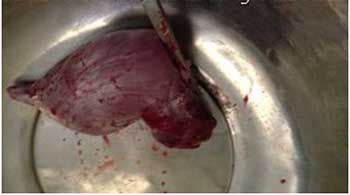
Types
Medical literature describes the following types of holoacardia based on their ultrasound appearances:
- Acardius amorphus: the most common presentation of holoacardia. The fetus, as in this case, lacks any clear anatomy and is replaced by an amorphous mass.
- Acardius acormus: the second most common presentation of holoacardia. The fetus lacks a thorax or chest.
- Acardius acephalus: the fetus lacks a head, thorax, or upper extremities.
- Acardius anceps: the fetus has most of the body parts but lacks even a poorly developed heart.
In most cases of holoacardia, the fetus usually has multiple other anomalies that make it incompatible with life.
Differential diagnosis
The main differential diagnoses for holoacardia amorphus include teratoma, omphalocele, gastroschisis, and ectopia cordis. As previously stated, careful study of the lesions will differentiate each of these conditions from holoacardia amorphus.
References:
Reference
Bonilla-Musoles F, Machado LE, Raga F, Osborne NG. Fetus acardius: two- and three-dimensional ultrasonographic diagnoses.
J Ultrasound Med.
2001;20:1117-1127.
S1E4: Dr. Kristina Adams-Waldorf: Pandemics, pathogens and perseverance
July 16th 2020This episode of Pap Talk by Contemporary OB/GYN features an interview with Dr. Kristina Adams-Waldorf, Professor in the Department of Obstetrics and Gynecology and Adjunct Professor in Global Health at the University of Washington (UW) School of Medicine in Seattle.
Listen
Study shows a healthy prenatal diet could be upstream obesity prevention strategy
December 26th 2024"Our findings support the recommendation of a healthy diet based on the current guidelines (as measured by the HEI) during pregnancy, since it may reduce patterns of infant growth outside reference ranges."
Read More
Early pregnancy cannabis use high in states with recreational legalization
November 11th 2024A population-based time-series analysis California before, during and after legalization show a rising trend in women using cannabis while pregnancy especially when the state has legalized the drug.
Read More
